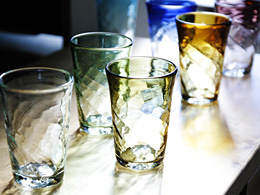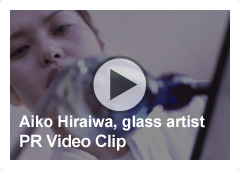Okinawan recycled glass is a type of glass that I like the most. Arter World War II, beer and coke bottles thrown by American soldiers were collected for glass making. They are broken into small pieces, melted, and reshaped into something new. The beauty of the process is that we turn waste glass is into amazing products.
It's like bringing new life into old bottles.
Aiko Hiraiwa, glass artist
Top page » Aiko Hiraiwa, glass artist



■ Aiko Hiraiwa, glass artist
After receiving her Bachelor of Fine Arts degree from the Musashino Art University, she started her apprenticeship at Okumura glass factory in Okinawa, where she learnt the art of Ryukyu glass making from Masao Tobara, famous modern glass artist.
After that, she was chosen to show her works in many galleries, and held private shows.
In 2009, she opened her gallery, Glass Studio Rainbow Leaf, in Ōme, Tokyo.

I went to Okinawa for the first time to see a person that I've never met. I saw his work at the library right before graduating from university. I was inspired by the message he put into his work and had a strong urge to create something like his.
Unfortunately, I found out about his death after arriving in Okinawa. Knowing no one in this strange island, I didn't know what to do and was overwhelmed.
I have always been interested in art and creative activities since I was a child. I majored in oil painting at college and mainly worked on portraits. I started to gain an interest in canvas backgrounds. As I tried to create a background with a transparent atmospheric tone, my focus shifted from two to three-dimensional works of art. I made up my mind to work on glass art, which would enable me to pursue two ideas - transparency and three-dimension.
I was looking for a way to learn the art of Ryukyu glass. Eventually I met Masao Toubaru, famous modern glass artist. When I met him, I just knew that I wanted to work with him. However, it took me time to convince him to take me as an apprentice because I am a woman. He said that women always give up career for marriage and children.
I didn't want to give up, despite his rejection. I kept writing letters until he took me as an apprentice. I've worked for Momohara at the Okuhara Glass Factory for seven years.
I'm done with my apprenticeship and opened my own studio with a kiln. We heat broken pieces of glass and blow them to reshape into a design that I imagined. I can see the connection between glass art and dreams coming true. I wouldn't be here If I didn't follow my inner voice and pursue my passion.
I would like to make simple and organic glassware rather than superficial works. Simple and practical. Soft yet powerful. That's my goal for glass making.



















